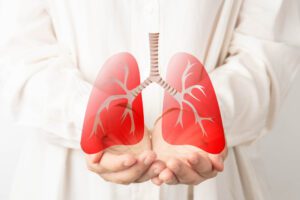Pulmonary Arterial Hypertension (PAH)
What is pulmonary arterial hypertension (PAH)?
Pulmonary arterial hypertension (PAH) is a chronic and progressive form of high blood pressure (hypertension) in the lungs that causes the pulmonary arteries to thicken or harden over time.
“Blood pressure” commonly refers to the blood circulation system that moves oxygenated blood through the left side of the heart to the body. There’s also a circulation system in the lungs for deoxygenated blood coming from the heart via the pulmonary artery. Normal pulmonary artery pressure is about 14 mm Hg (millimeters of mercury) at rest. Pressure in the pulmonary artery above 25 mm Hg at rest is considered pulmonary hypertension.
Pulmonary hypertension can happen when the tiny arteries of the lungs become narrow or blocked. Thus, the heart has to work harder than usual to force blood through and receive oxygen, and as a result, less oxygen-rich blood gets to the brain and body. Over time, the heart muscle weakens or becomes damaged, risking failure.
About 500-1,000 new cases of PAH are diagnosed in the United States each year; the incidence in Europe is similar. It’s twice as common in women than men. Women between 30-60 years old are usually affected.
What are the signs and symptoms of pulmonary arterial hypertension (PAH)?
Some people have no PAH symptoms until the disease has progressed considerably. Signs and symptoms include:
- Shortness of breath (called dyspnea) during exertion/increased activity
- Fainting, dizziness
- Chest pain
- Fatigue
- Swelling in ankles and legs
What causes pulmonary arterial hypertension (PAH)?
PAH is most commonly caused by a mutation in the gene BMPR2, which is thought to play a role in controlling the growth, division, and death (a regular and necessary stage of cell life called apoptosis) of certain cells.
PAH can also be caused by another disease or by using street drugs, such as cocaine. Diseases that can cause PAH include:
- HIV infection
- Congenital heart disease and congestive heart failure
- Sickle cell disease
- Liver disease
- Various connective tissue autoimmune diseases
- Lung diseases
How do people inherit pulmonary arterial hypertension (PAH)?
Sometimes (in about 15-20% of cases), there is a family history of PAH, known as familial pulmonary arterial hypertension. In those cases, the disease is passed down in an autosomal dominant pattern (meaning the altered gene need only be present in one parent to be passed down). The fact that a person has an altered gene does NOT mean that they’ll automatically get PAH, and many people who have the gene mutation never develop PAH.
Where can I find more information about pulmonary arterial hypertension (PAH)?
Pulmonary Arterial Hypertension (PAH) Articles

New Podcast Episode: Spreading PAH Awareness feat. Patient Advocate Steve Smith

PAH Drug Winrevair (Sotatercept) Receives Positive CHMP Opinion


Opsynvi Now Approved for Pulmonary Arterial Hypertension (PAH)

Winrevair is Now FDA-Approved for Pulmonary Arterial Hypertension (PAH)

Researchers Seek Reason for a Higher Survival Rate in Obese Patients with Pulmonary Arterial Hypertension (PAH)

Sotatercept Earns Priority Review for Treating Pulmonary Arterial Hypertension




